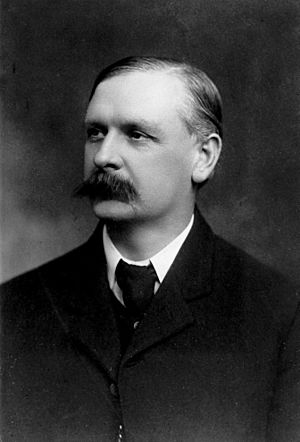Leonard Hill (physiologist) facts for kids
Quick facts for kids
Sir Leonard Erskine Hill
|
|
|---|---|

Sir L.E. Hill. Credit:Wellcome Library
|
|
| Born | 2 June 1866 |
| Died | 30 March 1952 (aged 85) Corton, Suffolk
|
| Nationality | British |
| Alma mater | Haileybury College, University College, London |
| Scientific career | |
| Fields | Medicine, Physiology |
Sir Leonard Erskine Hill (born June 2, 1866, in Tottenham, England; died March 30, 1952, in Corton, Suffolk) was a British scientist. He studied how the human body works, which is called physiology. He was a very important scientist.
In 1900, he became a Fellow of the Royal Society, a special group for top scientists. He was also made a "Sir" in 1930, which is a great honor. His father, George Birkbeck Hill, was a famous scholar. Leonard's son, Austin Bradford Hill, also became a well-known scientist.
Contents
Becoming a Scientist
Leonard Hill went to Haileybury College for his schooling. He later studied at University College, London. In 1890, he earned his medical degree there. Years later, in 1931, the University of Aberdeen gave him an honorary degree. This was to recognize his important work.
Discoveries in Medicine
Sir Leonard Hill did a lot of research on blood pressure. He wanted to find an easy way to measure it. He believed measuring blood pressure could be as simple as taking a person's temperature. His work helped develop what is now known as Hill's sign. This is a way to check for certain heart conditions.
He also received the T. K. Sidey Medal. This award is given for amazing scientific research. It was presented by the Royal Society of New Zealand.
Sir Leonard Hill was a big supporter of light therapy. This is using light to help people feel better. In 1924, he wrote a book called Sunshine and Open Air: Their Influence on Health. He believed that sunshine and fresh air were very important for good health.
Research on Diving
Sir Leonard Hill also studied how diving affects the human body. He looked into problems like decompression sickness. This happens when divers come up too fast from deep water. He also researched oxygen toxicity and the effects of carbon dioxide on divers.
He suggested a special way for divers to come up slowly from deep water. This method is still used today by saturation divers. His research was supported by companies that made diving equipment.
Other Interests
Besides being a scientist, Sir Leonard Hill was also an artist. He loved painting with watercolors. He even wrote stories for children! He enjoyed being outdoors very much. He used to swim every day in a pond in Epping Forest. He lived near there for a while before moving to Hampstead.
Selected Books
Sir Leonard Hill wrote many books about his scientific work and ideas:
- A Textbook of Physiology (with Martin William Flack, 1919)
- The Science of Ventilation and Open Air Treatment (1919)
- Sunshine and Open Air: Their Influence on Health (1924)
- Health and Environment (with Argyll Campbell, 1925)
- Philosophy of a Biologist (1930)
- Manual of Human Physiology (1935)
See also
- Decompression (diving)

